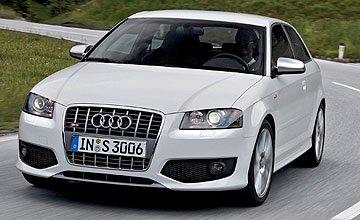BY CHRIS HARRIS | 20th Jun 2007

The new S3 promises boosted levels of power and equipment in a bigger body for a lower price than its predecessor.
The S3 is the performance figurehead for Audi’s A3 range, which was first launched in Australia in its current iteration in 2004. At $65,500, the new S3 sells for $1920 less than the S3 it replaces.
Like the previous S3, the new model is based on the two-door A3 bodyshell. The key points of difference between it and a standard A3 are the high-output turbocharged four-cylinder engine, six-speed close-ratio manual transmission and upgraded brakes.
The S3 shares the quattro AWD system with other A3s.
The successor to the original S3 is 55mm longer, 2mm wider, 16mm lower and has a wheelbase 59mm longer. Interior dimensions are improved, with 29mm of additional rear legroom and more shoulder room (up 42mm in the front, 23mm in the rear).
Audi Australia’s managing director Joerg Hofmann admitted last week that the S3 was very much a “niche vehicle”. While the previous model sold just 380 units in its four-year run (of a total 32,000 units worldwide), Mr Hofmann forecast Audi would sell 100 of the new S3 each year.
Audi believes it can glean the extra sales with the new model’s better value and performance plus improvements made to the Audi dealer network.
Management was reluctant to name the S3’s competitors, but the closest in price, dimensions and design is the S3’s cousin, the Volkswagen Golf R32. It will also rival BMW’s 130i.
The new S3 uses its own version of the Volkswagen Group’s TFSI 2.0-litre powerplant, producing 188kW and 330Nm, improvements of 23kW and 50Nm over the 1.8-litre engine in the previous S3.
Audi quotes a 0-100km/h time of 5.9 seconds and an electronically governed top speed of 250km/h. It also quotes a 9.2L/100km fuel consumption figure.
The same engine is used in lower states of tune in various other Volkswagen Group products, such as the Audi TT, A3 and A4, plus the Volkswagen Golf, Jetta and Passat.
For the S3, the engine has reinforced pistons, conrods, bearings and engine block to sustain the extra loadings placed on it. Compression ratio is high for a turbocharged engine at 9.8:1, and compared with the 147kW TFSI engine’s 0.9 bar boost, a bigger turbo is bolted on the S3 producing 1.2 bar.
The S3 destined for Australia actually uses a detuned version of this engine, with fully fledged European spec S3s producing 195kW and 350Nm. The result is a quoted 0-100km/h time of 5.7 seconds, 0.2 seconds quicker than the Australian version.
According to Audi, the Australian market S3 engine is a “hot country” engine (which also includes South Africa and parts of South America). Accordingly, an additional radiator was fitted and engine software mapping modified. The Australian S3’s quoted outputs are while running on either 95 RON or 98 RON premium unleaded.
The suspension sits 25mm lower than the standard A3, and brake discs are ventilated 17-inch diameter front and rear. The S3’s brakes also use specific high-performance brake pad material. The 18-inch alloy wheels are shod with 225/40R18 tyres, but the spare wheel is an 80km/h speed-limited steel space-saver.
Visually, the S3 is distinguished from other A3 models by its aluminium-look side mirror housings (a signature feature of the previous model), single frame grille, Xenon headlights (with daytime driving lights), roof spoiler, and deeper front and rear bumper bars and side skirts. Twin oval rear exhaust pipe outlets cap off the visual cues.
The interior features silk nappa leather seats, plus aluminium-look pedals, gearknob and air vents, “piano” finish dash, centre console and door inlays (brushed aluminium or birchwood are no-cost options). The S3 also has a Bose eight-speaker, 195W, MP3-compatible six-disc in-dash stacker sound system, dual-zone climate control, cruise control and a multi-function three-spoke steering wheel.
Safety features are numerous, and include front and front side airbags, side curtain airbags front and rear, ABS brakes (with EBD and brake assist) and stability and traction control. The front side airbags are not available with the optional sports front seats.
Key options are satellite navigation ($5300), racing-style leather front seats ($6700), a flat-bottom multi-function steering wheel ($700), dynamic cornering lights ($800), heated front seats ($800) and a sunroof ($1850). Metallic paint costs an additional $1300, while two-tone silk nappa seats is an additional $400.